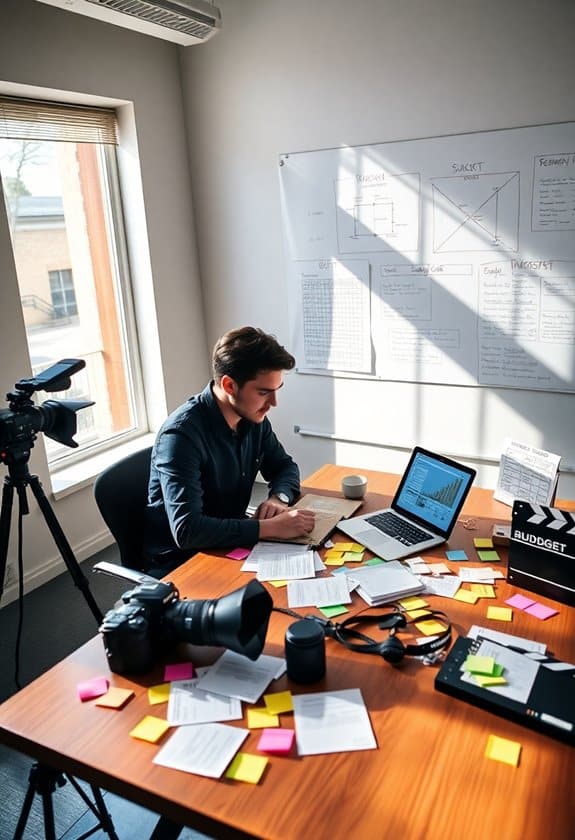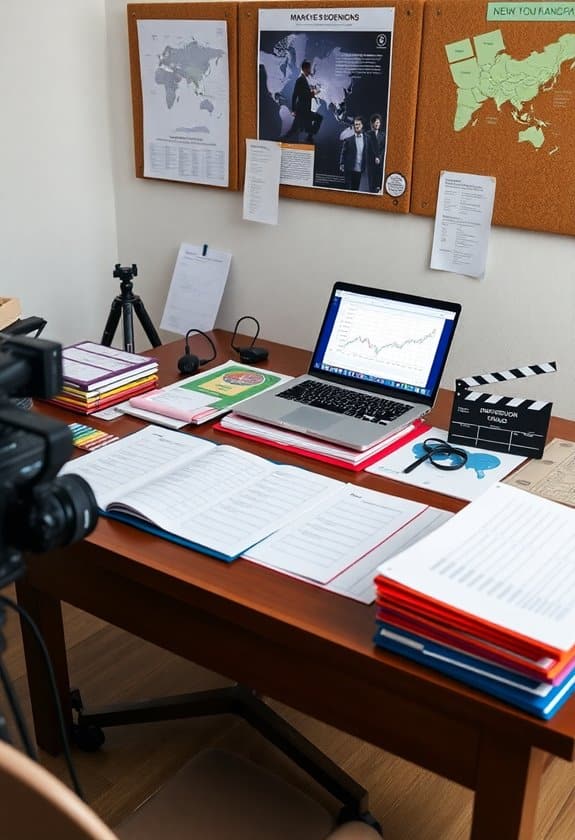Creating a film budget is your first step to a blockbuster, just without the popcorn and stardom—yet. Start by nailing down your project’s scope: define your film’s genre, length, and who you want to watch it. This helps avoid any surprise plot twists in costs. Next, estimate pre-production expenses for script development and securing locations and consider crew wages and equipment rental for production day. Don’t forget editing and sound design for post-production, before stashing away some cash for unexpected hiccups. Want to guarantee you won’t need a surprise lemonade stand fundraiser during reshoots? Keep your financial tracking tight.
Important Highlights
- Clearly define the project’s scope, including genre, length, and target audience, to guide budget decisions.
- Identify and estimate all pre-production costs, such as script development and location scouting, for accurate budgeting.
- Allocate funds for production expenses like crew wages, equipment rental, and location fees to ensure smooth operations.
- Plan for post-production costs, including editing and sound design, to avoid financial surprises later.
- Set aside a contingency fund to manage hidden or unexpected costs that may arise during production.
Understanding Your Project Scope

Understanding your project’s scope is essential to crafting an accurate film budget. It’s like setting the boundaries of your world, making certain you’re not lost in a sea of endless possibilities.
Start by clearly defining your film’s genre, length, and target audience. This approach helps you avoid unexpected surprises, like needing a flying car when you’ve only planned for a bicycle.
Picture each scene in your mind, considering locations, cast size, and special effects. Think about safety, too—always guarantee everyone’s well-being on set.
In my own experience, I found that detailed planning kept the production smooth and stress-free. Remember, knowing your scope helps you stay on track, guaranteeing you’re prepared for any twists along the way.
Estimating Pre-Production Costs

Once you’ve clearly defined your project’s scope, it’s time to tackle the financial groundwork by estimating pre-production costs. Think of this as setting a safe foundation for your film journey.
Start with essentials like script development, storyboarding, and location scouting. Remember, safety first—ensure your locations are secure and accessible.
Casting and crew selection are next; you want reliable folks who share your passion.
Now, here’s a tip from my own experience: invest in good insurance. It might sound boring, but it protects you from unexpected hiccups.
Also, allocate funds for permits. You don’t want your film dreams halted by red tape.
Approach this stage with care, like a builder crafting a home’s blueprint, ensuring everything fits perfectly.
Calculating Production Expenses

When it comes to calculating production expenses, you’ll plunge into the heart of your film’s financial framework. It’s like diving into a pool of numbers, all hoping you’ll keep them afloat!
Start with your crew’s wages. They’re the backbone, and ensuring they’re paid fairly is key to a smooth shoot. Equipment rental sneaks up fast, so list everything—from cameras to cables. Additionally, investing in the right best cameras for filmmaking can significantly enhance your production quality.
Don’t forget about location fees. Picking the perfect setting is thrilling, but it’s important to know its cost upfront. Transportation and meals need careful planning, too. Everyone’s gotta eat, right?
Accounting for Post-Production

As you shift into post-production, sharpen your focus on the details that will bring your film to life. This stage is where the magic truly happens, but it can be a bit like herding cats—lots of moving parts!
You’ll need to budget for editing, sound design, visual effects, and color correction. Remember, safety nets are your best friend here; unexpected costs can pop up like surprise pop quizzes.
My first film taught me this when an audio issue nearly doubled my expenses. Plan for contingencies, and always have a little wiggle room in your budget.
Hiring skilled professionals is essential, so allocate funds wisely. It’s much better to invest in quality now than to regret it later. Additionally, consider investing in essential editing equipment to optimize your workflow and enhance the final product.
Stay prepared, stay safe!
Planning for Marketing and Distribution

Starting on the journey of planning for marketing and distribution is essential to your film’s success. Imagine this: you’ve poured your heart and soul into creating your film, but without a solid marketing plan, it might remain unseen.
You’ll need to think about your target audience and the best platforms to reach them. Consider setting aside funds for social media campaigns, posters, and even local screenings.
Remember, the safer your approach, the better your chances of reaching your audience without unnecessary risks. From my own experience, not having a plan can feel like being lost at sea without a compass.
Identifying Hidden Costs

Uncovering hidden costs is essential to maintaining control over your film budget. You don’t want any surprises sneaking up on you!
I remember my first film project when the unexpected costs of permits and insurance crept in like mischievous little gremlins. It taught me the importance of planning ahead.
Always consider unforeseen expenses, like last-minute location changes, extra meals for your crew, or even overtime pay. These hidden costs can add up quickly, so it’s wise to set aside a contingency fund. Think of it as your film’s safety net.
Also, remember those little things, like extra batteries or parking fees. They may seem tiny, but they can surprise you. Keep your eyes peeled, and you’ll navigate through smoothly! Investing in affordable filmmaking gear can help you manage costs more effectively.
Negotiating With Vendors

After spotting those hidden costs, you’re better prepared to tackle the next step: negotiating with vendors.
Think of it like a friendly chat, though sometimes it feels like a high-stakes game of chess! Approach vendors with confidence and a clear idea of what you need.
Remember, safety in numbers—gather quotes from multiple sources to guarantee you’re getting the best deal.
When I negotiated camera rentals for my first film, I realized that being polite yet persistent often opened doors to discounts.
Always ask about package deals or student rates if you’re part of a film school.
And don’t be afraid to say, “Can we work something out?” Vendors appreciate honest communication, and it often leads to a win-win situation. Additionally, considering the essential gear for professional movie-making can help you identify what to negotiate for in terms of quality and functionality.
Allocating Contingency Funds

Allocating contingency funds is your safety net in the unpredictable world of filmmaking. Imagine you’re on set, and suddenly, a storm rolls in, threatening to wash away your perfectly planned outdoor scene. That’s where contingency funds save the day!
These funds are like a superhero cape, ready to swoop in and cover unexpected costs. Ideally, you should set aside about 10% of your total budget for these surprises.
It’s like having a secret stash of snacks for a long road trip—you mightn’t need them, but boy, will you be glad they’re there if you do!
Tracking Your Spending

Keeping a close eye on your expenditures is essential to staying within your film’s budget. Imagine your budget as a treasure map. If you don’t track your steps, you might end up lost or, worse, broke!
Keep a detailed record of every penny spent. Use spreadsheets or budgeting apps that make it easy to update expenses as they happen. Remember, small costs, like snacks for the crew, add up quickly.
I once thought I’d saved enough for a big premiere party, only to realize I’d overspent on coffee runs! Stay organized and double-check receipts to keep surprises at bay.
It’s not just about the numbers; it’s about ensuring your film journey remains smooth and successful without financial hiccups.
Reviewing and Adjusting the Budget

Your film’s budget isn’t set in stone; it’s a living document that needs regular attention. You might feel like a budgeting wizard, but even the best plans can change.
As you move through production, unexpected costs pop up, just like a surprise rainstorm on a sunny day. Maybe a prop breaks or an actor needs a last-minute flight—adjustments are part of the filmmaking adventure.
Regularly reviewing your budget helps you spot these changes early. It’s like checking your map while on a road trip to guarantee you’re on the right path.
Always ask yourself: Are there areas where you can save? Can you shift funds from one department to another? Staying flexible keeps your project on track and safe from financial surprises.
Frequently Asked Questions
How Do You Factor in Tax Incentives and Rebates in a Film Budget?
When you’re figuring out tax incentives and rebates for your film budget, start by researching where you’ll shoot.
Many places offer sweet deals to attract filmmakers. It’s like finding hidden treasures! You’ll want to chat with local film offices to get the scoop on what’s available.
What Software Tools Are Recommended for Film Budget Management?
When you’re diving into the world of film budgeting, it’s like baking a big cake—lots of ingredients and precision are needed!
For managing your budget, tools like Movie Magic Budgeting and Gorilla Budgeting are your safe bet. They keep everything tidy and let you focus on the creative bits.
Once, I tried using a spreadsheet, but things got messy quickly. Trust me, these tools make it easier, and you’ll sleep better knowing your budget’s on track!
How Can Filmmakers Secure Funding for Independent Projects?
To secure funding for your indie film, start by crafting a compelling pitch.
You’ll want to connect emotionally with potential investors. Crowdfunding platforms like Kickstarter can be a safe way to gather support from friends and fans.
You might also consider film grants—research and apply to those that fit your project.
Don’t overlook private investors; sometimes, a passionate pitch over coffee works wonders.
What Are Common Legal Considerations When Creating a Film Budget?
When you’re creating a film budget, legal considerations can be like a puzzle. Always remember to account for contracts with actors and crew.
You wouldn’t want to miss permits for locations—that’d be a huge oops! Insurance is also essential; it keeps everyone safe and sound on set.
Copyrights for music and scripts? Yep, those too. Think of it as a checklist, ensuring everything’s covered so your film dreams stay on track.
How Should You Handle Unexpected Drops in Funding During Production?
When unexpected funding drops, don’t panic—adapt!
First, prioritize essential expenses like paying your crew and securing locations.
Remember that time you had to film with an iPhone? It taught you creativity is key.
Cut non-essential costs and negotiate with suppliers for discounts.
Keep your team informed and motivated; they’re your creative family.
Finally, explore alternative funding sources like crowdfunding.
Stay flexible, because filmmaking is all about resourcefulness and passion!




